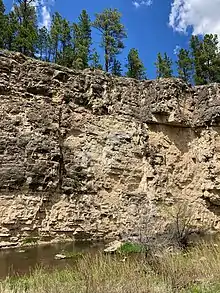Pahasapa Formation
The Pahasapa Formation is a geological unit of primarily limestone and dolostone[3] that is exposed in the Black Hills of South Dakota and northwestern Wyoming, and underlies parts of Nebraska.[4] Also referred to as the Pahasapa Limestone (especially in older publications and outside South Dakota), this unit is analogous to the Madison Limestone[1] and the Burlington Limestone,[5] other Mississippian-aged limestones and dolostones in the midwestern United States. Two of the ten longest caves in the world are found in the Pahasapa.[6]
| Pahasapa Formation | |
|---|---|
| Stratigraphic range: Mississippian,[1] | |
 An exposure of the cliff forming Pahasapa west of Rapid City, along Nemo Road. The karstic tendencies of the unit are clearly visible in the pitting of the face. | |
| Type | Formation |
| Underlies | Minnelusa Formation[2] |
| Overlies | Englewood Formation[2] |
| Thickness | 225-500 ft[1] |
| Lithology | |
| Primary | Limestone |
| Other | Dolostone, dolomitic limestone |
| Location | |
| Region | South Dakota, Wyoming, Nebraska |
| Country | United States |
| Type section | |
| Named for | the Dakota people's name for the Black Hills[1] |
Lithology
The Pahasapa consists mainly of grey massive limestone and dolostone[1] that tends sparitic.[7] The central Black Hills Pahasapa is more dominantly dolostone, while the outer fringes tend more strongly limestone.[7] In the upper sections, it can consist of limestone interbedded with dolomites, or simply evaporite dolostones.[8]
Fossil Content
As the Pahasapa is a marine limestone, the fossils it contains are primarily brachiopods and corals,[1] along with some crinoid plates and bryozoans.[7] Corals are chiefly Syringopora, and are found generally found near the gradational contact with the Englewood Formation. Also found were the molluscs Bellerophon, Euomphalus, and the marine invertebrates Pentremites.[1] Burrows, a trace fossil left by species working the sediment before it lithified, are also common in the lower sections of the formation.[9]
In the sections of the Pahasapa that have been dolomitized, many of the fossils have been destroyed due to recrystallization of the calcium carbonate, and those that remain have a distinctive "sugary" appearance.[9]
Features
All of the caves in the Black Hills are developed in the Pahasapa.[7] Two of the most notable of these caves are Wind Cave, the seventh largest cave in the world,[6] and Jewel Cave, the third largest cave in the world.[6] Wind Cave is known for its calcite box work, a distinctive speleothem, and its passages that intersect with paleocave fill, indicating Mississippian-era caves that developed and then were flooded with sediment.[9]
See also
Citations
- Darton, N.H. (1901). "Preliminary description of the geology and water resources of the southern half of the Black Hills and adjoining regions in South Dakota and Wyoming" (PDF). U.S. Geological Survey Annual Report. 21 (pt. 4): 489. Retrieved 11 June 2021.
- Feldman, R.M.; Heimlich, R.A. (1980). The Black Hills Field Guide. Dubuque: Kendell/Hunt Publishing Co. p. 190.
- Butler, R.J.; Battin, R.L.; Winston, G.O. (1955). "Lithologic correlation of middle and lower Paleozoic rocks". North Dakota Geological Society Field Conference Guidebook. 3: 38–42.
- Condra, G.E.; Schramm, E.F.; Lugn, A.L. (1931). "Deep Wells of Nebraska". Nebraska Geological Survey Bulletin. 2nd Series (4).
- Darton, N.H. and Paige, Sidney (1925). Central Black Hills folio, South Dakota (Map). 1:125,000. Geologic Atlas of the United States. United States Geological Survey. p. GF-219.
{{cite map}}: CS1 maint: multiple names: authors list (link) - Gulden, Bob (2021-10-04). "Worlds longest caves". Geo2 Committee on Long and Deep Caves. National Speleological Society (NSS). Retrieved 2021-10-08.
- Najjar, Abdullatif (1971). "Dolomitized Pahasapa Limestone (Mississippian), northeastern sector of the Black Hills, South Dakota, petrography and geological setting". Scholars's Mine.
- Andrichuck, J.M. (1955). "Mississippian Madison group stratigraphy and sedimentation in Wyoming and southern Montana". American Association of Petroleum Geologists. 39 (11): 2170.
- KellerLynn, K. (2009). Wind Cave National Park Geologic Resources Inventory Report, Natural Resource Report NPS/NRPC/GRD/NRR-2009/087. Denver: National Park Service. pp. 14–15, 29–30.